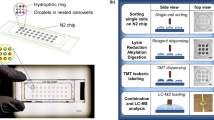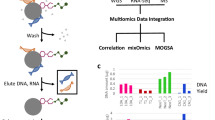Abstract
A critical step in proteomics analysis is the optimal extraction and processing of protein material to ensure the highest sensitivity in downstream detection. Achieving this requires a sample-handling technology that exhibits unbiased protein manipulation, flexibility in reagent use, and virtually lossless processing. Addressing these needs, the single-pot, solid-phase-enhanced sample-preparation (SP3) technology is a paramagnetic bead–based approach for rapid, robust, and efficient processing of protein samples for proteomic analysis. SP3 uses a hydrophilic interaction mechanism for exchange or removal of components that are commonly used to facilitate cell or tissue lysis, protein solubilization, and enzymatic digestion (e.g., detergents, chaotropes, salts, buffers, acids, and solvents) before downstream proteomic analysis. The SP3 protocol consists of nonselective protein binding and rinsing steps that are enabled through the use of ethanol-driven solvation capture on the surface of hydrophilic beads, and elution of purified material in aqueous conditions. In contrast to alternative approaches, SP3 combines compatibility with a substantial collection of solution additives with virtually lossless and unbiased recovery of proteins independent of input quantity, all in a simplified single-tube protocol. The SP3 protocol is simple and efficient, and can be easily completed by a standard user in ~30 min, including reagent preparation. As a result of these properties, SP3 has successfully been used to facilitate examination of a broad range of sample types spanning simple and complex protein mixtures in large and very small amounts, across numerous organisms. This work describes the steps and extensive considerations involved in performing SP3 in bottom-up proteomics, using a simplified protein cleanup scenario for illustration.
This is a preview of subscription content, access via your institution
Access options
Access Nature and 54 other Nature Portfolio journals
Get Nature+, our best-value online-access subscription
$29.99 / 30 days
cancel any time
Subscribe to this journal
Receive 12 print issues and online access
$259.00 per year
only $21.58 per issue
Buy this article
- Purchase on Springer Link
- Instant access to full article PDF
Prices may be subject to local taxes which are calculated during checkout




Similar content being viewed by others
References
Wingren, C. Antibody-based proteomics. Adv. Exp. Med. Biol. 926, 163–179 (2016).
Larance, M. & Lamond, A. I. Multidimensional proteomics for cell biology. Nat. Rev. Mol. Cell Biol. 16, 269–280 (2015).
Aebersold, R. & Mann, M. Mass-spectrometric exploration of proteome structure and function. Nature 537, 347–355 (2016).
Gillet, L. C., Leitner, A. & Aebersold, R. Mass spectrometry applied to bottom-up proteomics: entering the high-throughput era for hypothesis testing. Annu. Rev. Anal. Chem. 9, 449–472 (2016).
Aebersold, R. & Mann, M. Mass spectrometry-based proteomics. Nature 422, 198–207 (2003).
Feist, P. & Hummon, A. B. Proteomic challenges: sample preparation techniques for microgram-quantity protein analysis from biological samples. Int. J. Mol. Sci. 16, 3537–3563 (2015).
Kuljanin, M., Dieters-Castator, D. Z., Hess, D. A., Postovit, L.-M. & Lajoie, G. A. Comparison of sample preparation techniques for large-scale proteomics. Proteomics 17, 1600337 (2017).
León, I. R., Schwämmle, V., Jensen, O. N. & Sprenger, R. R. Quantitative assessment of in-solution digestion efficiency identifies optimal protocols for unbiased protein analysis. Mol. Cell. Proteomics 12, 2992–3005 (2013).
Glatter, T. et al. Large-scale quantitative assessment of different in-solution protein digestion protocols reveals superior cleavage efficiency of tandem Lys-C/trypsin proteolysis over trypsin digestion. J. Proteome Res. 11, 5145–5156 (2012).
Kulak, N. A., Pichler, G., Paron, I., Nagaraj, N. & Mann, M. Minimal, encapsulated proteomic-sample processing applied to copy-number estimation in eukaryotic cells. Nat. Methods 11, 319–324 (2014).
Rappsilber, J., Ishihama, Y. & Mann, M. Stop and go extraction tips for matrix-assisted laser desorption/ionization, nanoelectrospray, and LC/MS sample pretreatment in proteomics. Anal. Chem. 75, 663–670 (2003).
Jiang, L., He, L. & Fountoulakis, M. Comparison of protein precipitation methods for sample preparation prior to proteomic analysis. J. Chromatogr. A 1023, 317–320 (2004).
Manza, L. L., Stamer, S. L., Ham, A.-J. L., Codreanu, S. G. & Liebler, D. C. Sample preparation and digestion for proteomic analyses using spin filters. Proteomics 5, 1742–1745 (2005).
Wiśniewski, J. R., Zougman, A., Nagaraj, N. & Mann, M. Universal sample preparation method for proteome analysis. Nat. Methods 6, 359–362 (2009).
Stepanova, E., Gygi, S. P. & Paulo, J. A. Filter-based protein digestion (FPD): a detergent-free and scaffold-based strategy for TMT workflows. J. Proteome Res. 17, 1227–1234 (2018).
Ethier, M., Hou, W., Duewel, H. S. & Figeys, D. The proteomic reactor: a microfluidic device for processing minute amounts of protein prior to mass spectrometry analysis. J. Proteome Res. 5, 2754–2759 (2006).
Chen, W.-H. et al. Solid-phase extraction and elution on diamond (SPEED): a fast and general platform for proteome analysis with mass spectrometry. Anal. Chem. 78, 4228–4234 (2006).
Zougman, A., Selby, P. J. & Banks, R. E. Suspension trapping (STrap) sample preparation method for bottom-up proteomics analysis. Proteomics 14, 1006–1000 (2014).
Chen, W. et al. Simple and integrated spintip-based technology applied for deep proteome profiling. Anal. Chem. 88, 4864–4871 (2016).
Hughes, C. S. et al. Ultrasensitive proteome analysis using paramagnetic bead technology. Mol. Syst. Biol. 10, 757 (2014).
Alpert, A. J. Hydrophilic-interaction chromatography for the separation of peptides, nucleic acids and other polar compounds. J. Chromatogr. 499, 177–196 (1990).
Moggridge, S., Sorensen, P. H., Morin, G. B. & Hughes, C. S. Extending the compatibility of the SP3 paramagnetic bead processing approach for proteomics. J. Proteome Res. 17, 1730–1740 (2018).
Virant-Klun, I., Leicht, S., Hughes, C. & Krijgsveld, J. Identification of maturation-specific proteins by single-cell proteomics of human oocytes. Mol. Cell. Proteomics 15, 2616–2627 (2016).
Sielaff, M. et al. Evaluation of FASP, SP3, and iST protocols for proteomic sample preparation in the low microgram range. J. Proteome Res. 16, 4060–4072 (2017).
Nagala, M. et al. Expression of siglec-E alters the proteome of lipopolysaccharide (LPS)-activated macrophages but does not affect LPS-driven cytokine production or toll-like receptor 4 endocytosis. Front. Immunol. 8, 1926 (2017).
Höhne, M. et al. Single nephron proteomes connect morphology and function in proteinuric kidney disease. Kidney Int. 93, 1308–1319 (2018).
Hughes, C. S. et al. Quantitative profiling of single formalin fixed tumour sections: proteomics for translational research. Sci. Rep. 6, 34949 (2016).
Owen, D. R. et al. Molecular characterization of ERBB2-amplified colorectal cancer identifies potential mechanisms of resistance to targeted therapies: a report of two instructive cases. Cold Spring Harb. Mol. Case Stud. 4, a002535 (2018).
Tien, J. F. et al. CDK12 regulates alternative last exon mRNA splicing and promotes breast cancer cell invasion. Nucleic Acids Res. 45, 6698–6716 (2017).
Cagnetta, R., Frese, C. K., Shigeoka, T., Krijgsveld, J. & Holt, C. E. Rapid cue-specific remodeling of the nascent axonal proteome. Neuron 99, 29–46.e4 (2018).
Conrad, S., Azizi, H. & Skutella, T. Single-cell expression profiling and proteomics of primordial germ cells, spermatogonial stem cells, adult germ stem cells, and oocytes in Advances in Experimental Medicine and Biology (eds Chattopadhyay, K & Subhash, C.) 117 (2018).
Ly, T. et al. Proteomic analysis of cell cycle progression in asynchronous cultures, including mitotic subphases, using PRIMMUS. Elife 6, e27574 (2017).
Buczak, K. et al. Spatial tissue proteomics quantifies inter- and intra-tumor heterogeneity in hepatocellular carcinoma. Mol. Cell. Proteomics 17, 810–825 (2018).
Savitski, M. M. et al. Multiplexed proteome dynamics profiling reveals mechanisms controlling protein homeostasis. Cell 173, 260–274.e25 (2018).
Mateus, A. et al. Thermal proteome profiling in bacteria: probing protein state in vivo. Mol. Syst. Biol. 14, e8242 (2018).
Larsbrink, J. et al. Proteomic insights into mannan degradation and protein secretion by the forest floor bacterium Chitinophaga pinensis. J. Proteomics 156, 63–74 (2017).
Esquirol, L. et al. An unexpected vestigial protein complex reveals the evolutionary origins of an s-triazine catabolic enzyme. J. Biol. Chem. 293, 7880–7891 (2018).
Rafiee, M.-R., Girardot, C., Sigismondo, G. & Krijgsveld, J. Expanding the circuitry of pluripotency by selective isolation of chromatin-associated proteins. Mol. Cell 64, 624–635 (2016).
Åhrman, E. et al. Quantitative proteomic characterization of the lung extracellular matrix in chronic obstructive pulmonary disease and idiopathic pulmonary fibrosis. J. Proteomics 189, 23–33 (2018).
Batth, T. S. et al. Protein aggregation capture on microparticles enables multi-purpose proteomics sample preparation. Preprint at https://www.biorxiv.org/content/early/2018/10/25/447904 (2018).
Kovalchik, K. A., Moggridge, S., Chen, D. D. Y., Morin, G. B. & Hughes, C. S. Parsing and quantification of raw orbitrap mass spectrometer data using RawQuant. J. Proteome Res. 17, 2237–2247 (2018).
Vaudel, M., Barsnes, H., Berven, F. S., Sickmann, A. & Martens, L. SearchGUI: an open-source graphical user interface for simultaneous OMSSA and X!Tandem searches. Proteomics 11, 996–999 (2011).
Vaudel, M. et al. PeptideShaker enables reanalysis of MS-derived proteomics data sets. Nat. Biotechnol. 33, 22–24 (2015).
Vizcaíno, J. A. et al. 2016 update of the PRIDE database and its related tools. Nucleic Acids Res. 44, 11033 (2016).
Acknowledgements
C.S.H. acknowledges valuable discussions with L. Radan. The authors acknowledge support from the British Columbia Cancer Foundation Multimedia team for assistance in the creation of video protocols. G.B.M. and P.H.S. acknowledge funding support from the British Columbia Cancer Foundation for this work. S.M. acknowledges funding support from the British Columbia Proteomics Network. J.K. acknowledges funding from the CellNetworks Excellence Cluster.
Author information
Authors and Affiliations
Contributions
C.S.H. and J.K. conceived the idea. C.S.H. designed the protocol, analyzed the data, and wrote the manuscript. S.M. and C.S.H. contributed to the creation of the protocol video. S.M., T.M., P.H.S., G.B.M., and J.K. contributed to editing and content of the manuscript.
Corresponding authors
Ethics declarations
Competing interests
The authors declare no competing interests.
Additional information
Publisher’s note: Springer Nature remains neutral with regard to jurisdictional claims in published maps and institutional affiliations.
Related links
Key references using this protocol
Hughes, C. S. et al. Mol. Syst. Biol. 10, 757 (2014) https://doi.org/10.15252/msb.20145625
Moggridge, S., Sorensen, P. H., Morin, G. B. & Hughes, C. S. J. Proteome Res. 17, 1730–1740 (2018) https://doi.org/10.1021/acs.jproteome.7b00913
Supplementary information
Supplementary Video 1
Handling of protein samples with SP3 for MS analysis. The video depicts all steps of the SP3 protocol, along with specific visualizations to aid in interpretation of the described protocol
Rights and permissions
About this article
Cite this article
Hughes, C.S., Moggridge, S., Müller, T. et al. Single-pot, solid-phase-enhanced sample preparation for proteomics experiments. Nat Protoc 14, 68–85 (2019). https://doi.org/10.1038/s41596-018-0082-x
Published:
Issue Date:
DOI: https://doi.org/10.1038/s41596-018-0082-x
This article is cited by
-
TopBP1 utilises a bipartite GINS binding mode to support genome replication
Nature Communications (2024)
-
Functionalizing tandem mass tags for streamlining click-based quantitative chemoproteomics
Communications Chemistry (2024)
-
Structural basis for RAD18 regulation by MAGEA4 and its implications for RING ubiquitin ligase binding by MAGE family proteins
The EMBO Journal (2024)
-
A new mass analyzer shakes up the proteomics field
Nature Biotechnology (2024)
-
Phosphorylation of ELYS promotes its interaction with VAPB at decondensing chromosomes during mitosis
EMBO Reports (2024)
Comments
By submitting a comment you agree to abide by our Terms and Community Guidelines. If you find something abusive or that does not comply with our terms or guidelines please flag it as inappropriate.



